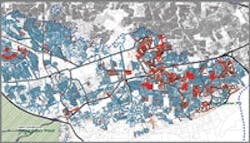Isolating Inflow & Infiltration
About the author: Lauryn Colquitt is marketing coordinator with Mission Communications. Colquitt can be reached at [email protected] or 678.969.0021.
Duckett Creek Sanitary District (DCSD), located in O’Fallon, Mo., was experiencing inflow and infiltration problems, causing backups and overflows. When annual bypass reports submitted to the U.S. Environmental Protection Agency (EPA) indicated noncompliance with federal regulations, Keith Arbuckle, DCSD director of engineering, collaborated with EPA officials to improve system operation and maintenance. Both parties agreed to implement a CMOM (capacity, management, operations and maintenance) program to circumvent noncompliance fees and reduce bypasses. For the past six years, DCSD has worked diligently to create a more efficient system, reduce costs and eliminate backup events.
Inflow & Infiltration Defined
Inflow and infiltration are persistent problems that plague all sewer collection systems. Inflow refers to storm water that flows into sewer systems through direct connections such as roof and foundation drains, storm drain connections and uncapped cleanouts. These sources typically are improperly or illegally connected to sanitary sewer mains. Infiltration is groundwater that seeps into sanitary sewer systems through faulty joints, cracks and areas of root intrusion in the sewer pipes. Sources of infiltration generally are the result of aging infrastructure.
Sanitary sewer overflows (SSOs) occur as a result of inflow and infiltration. When storm water and groundwater enter the sanitary sewer system, they must be treated like wastewater. Increases in flow during rain events often causes sewer backups and overflows. SSOs overburden treatment facility equipment, reduce treatment facility sustainability and contribute to increases in regulatory fines for noncompliance. Implementing preventive measures to eliminate SSOs and CSOs is more cost-effective than correcting problems as they occur.
Detecting the Problem
The integrity of a sewer collection system is most accurately gauged through recording and analyzing flow measurements at important points throughout the system. Conventional methods of recording flow data can be expensive. For initial inspection, Arbuckle used the Runtime vs. Rainfall report provided by Mission Communications as an alternative. The report is used during wet and dry seasons to evaluate sewer systems for potential inflow and infiltration problems. With the report, users can determine if inflow or infiltration is the primary source of entry into the sewer system during rainfall events. If the Runtime vs. Rainfall report shows that inflow and infiltration is present, flow measurement tools can be used to more accurately measure the problem.
Consistent and continuous flow monitoring data is a key component of a well-designed Sewer System Evaluation Study, which is a long-term system analysis aimed to ascertain the scope of the problem and assess various solutions. Smoke testing, manhole inspections, dye testing and video inspection also can be used to locate points of inflow and infiltration. The extent of the problem can be determined by quantified or observed overflows and surcharges, reported bypasses, backup complaints and excessive maintenance activities.
Evaluating the Problem
Arbuckle began the sewer system investigation by observing the Runtime vs. Rainfall report. “When we had a significant rain event, I looked at the data and it indicated that we had more inflow than infiltration because peak flow occurred directly after a rain event. We had to battle infiltration, but it wasn’t as bad as the inflow,” Arbuckle said. The report helped Arbuckle identify problem areas by determining where to place video cameras along the trunk and lateral lines. Video inspection unveiled multiple cracked pipes and root intrusion. The data from the Runtime vs. Rainfall report and video inspection were used to plot locations on district maps that were urgently in need of repair. A green line displayed the rainfall, while red and blue bars displayed the pump run times.
DCSD used video inspection to inform homeowners of root intrusion in their lateral lines.
From Plan to Action
DCSD subsequently received a $200,000 state-wide grant to assist with infrastructure rehabilitation. “We made the decision early on in the process to focus our attention on the manholes first,” Arbuckle said. “We identified leaks in manhole covers and vandalism as a major source of our inflow problem.”
Excess water from golf course fairways and farm fields was being dumped into nearby manholes. “Objects ranging from large plastic Easter eggs to car transmissions obstructed the flow and had to be removed. One of our goals was to eliminate vandalism,” Arbuckle said. “The EPA doesn’t recognize these kinds of things in reports, but it is our job to make sure they don’t happen.”
DCSD replaced the lids on 500 manholes with sealed and locked lids. Manholes with severe cracks and holes were lined with cement. DCSD sent notification letters to homeowners when root intrusion or cracks were found in lateral lines to prevent backups from occurring. Homeowners were pleased with DCSD for its proactive efforts.
Continuous Improvements
DCSD was the first district in Missouri to implement membrane bioreactor (MBR) technology at several of the district treatment plants. This new technology is used to release effluent that is five times cleaner than local creek water. The two MBR treatment plants were engineered and designed to blend in with other nearby structures. One of the treatment plants is camouflaged inside a home, while the other is enclosed in a red barn.
“The treatment plants came with SCADA systems, but we didn’t like them. We preferred the Mission Communications SCADA system because the call-out system is more efficient and it works great in conjunction with everything else,” Arbuckle said.
Instead of occupying a larger footprint by building remote facilities, DCSD decided that the home and barn were the best options for environmental sustainability and future expenses.
“We are still in the process of rehabilitating the system, but costs have dramatically decreased as a result of our efforts to eliminate inflow and infiltration. The Runtime vs. Rainfall report from Mission Communications gave us great insight into our problems,” Arbuckle said.
Download: Here
